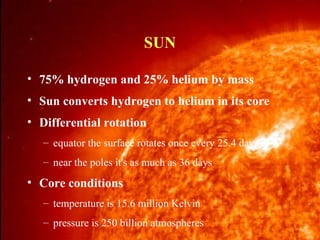
Solarsystem
- 1. SUN • 75% hydrogen and 25% helium by mass • Sun converts hydrogen to helium in its core • Differential rotation – equator the surface rotates once every 25.4 days – near the poles it's as much as 36 days • Core conditions – temperature is 15.6 million Kelvin – pressure is 250 billion atmospheres Norm Herr (sample file) 11/15/99
- 2. MERCURY • Orbit – highly eccentric – perihelion 46 million km – aphelion it is 70 million km • Closest to sun • Appears to travel fastest • 8th largest 11/15/99 Norm Herr (sample file)
- 3. VENUS • 2nd from Sun • 6th largest • brightest • inferior planet – shows phases when viewed from Earth – Galileo's observed phases – Copernicus used data to develop heliocentric theory. 11/15/99 Norm Herr (sample file)
- 4. EARTH • 3rd from the Sun • Moon is 1/6 mass of earth • period of rotation: 24 hours • period of orbit 365.25 days 11/15/99 Norm Herr (sample file)
- 5. Where are you? 11/15/99 Norm Herr (sample file)
- 6. MARS • • • • Mars is the 4th Planet from the Sun Solid carbon dioxide is found at the poles Mars is known as the Red Planet Visit JPL’s Mars Exploration Page 11/15/99 Norm Herr (sample file)
- 7. JUPITER • Jupiter contains over 70% of the mass in the solar system outside the Sun. • It is about 11 times the radius and 330 times the mass of the earth. • It is the first representative of the outer solar system. • Unlike the inner planets, Jupiter is not a solid body, but instead is a ball of gas and liquid (mostly hydrogen and helium). – From the earth, there are two obvious clues to this: – 1. Jupiter, which rotates extremely rapidly (a period of about 10 hours), has a significant bulge at the equator. We call this oblateness, and – Jupiter has an oblateness of about 6%, which means that the equatorial diameter is 6% greater than the polar diameter. – 2. In addition, Jupiter rotates differentially, just as the Sun does. The period of rotation at the poles is about 10 minutes less than that of the equator, while the interior rotates at an intermediate speed. 11/15/99 Norm Herr (sample file)
- 8. SATURN • Saturn: – – It has strong surface winds (500 m/sec). – Saturn is less dense than water. – • Saturn is a gas giant. Saturn’s magnetic field is 20x less than Jupiter's, but its core rotation period (10.5 hours) is similar. Saturn’s Moons: – Titan is the big one, and is larger than planet Mercury! – Mimas has a huge crater. – Epimetheus and Janus, just inside the orbit of Mimas, are continually exchanging orbits with one another in a "waltz" -- they are called the coorbital satellites. 11/15/99 Norm Herr (sample file)
- 9. URANUS • Uranus has more moons (15) than any other planet except Jupiter (16) and Saturn (23)! 25 20 Mercury Earth Mars Jupiter Saturn Uranus Neptune Pluto 15 10 5 11/15/99 0 Norm Herr (sample file)
- 10. NEPTUNE • The blue coloration of Neptune is probably due to the presence of methane Note the apparent storms 11/15/99 Norm Herr (sample file)
- 11. PLUTO • Pluto is very small as planets go, only 0.002 Earth masses. • Pluto’s orbit is elliptical : it varies from 29 to 49 A.U. from the Sun, crossing inside of Neptune's orbit. • Pluto's orbit is inclined 17deg to the ecliptic, so it goes farther above and below the plane in which the other planets formed than any other planet. 11/15/99 Norm Herr (sample file)
- 12. Sample Quiz Questions Question: Which of the planets are rocky? Answer: The inner planets: Mercury, Venus, Earth and Mars 11/15/99 Norm Herr (sample file)
- 13. Sample Question 2 • Which of the planets has the most satellites? Saturn! 11/15/99 Norm Herr (sample file)
- 14. Credits • This sample file was created by Norm Herr for use in SED 619 at CSUN • Photographs are provided by the National Aeronautics and Space Administration Menu Home 11/15/99 Norm Herr (sample file)
Notes de l'éditeur
- I. Uranus (This data is from: http://www.geocities.com/ResearchTriangle/2389/ch_19_26_stdy_gd.html) A. Discovery and Orbit Uranus was discovered in 1781 by Herschel. This caused a sensation, because everyone had assumed they knew all the planets that there were. Its orbit is very slightly elliptical, its year is 84 Earth years long (because -- remember P2=a3 -- it's at an average distance "a" of 19.18 A.U.). Its weirdest feature is that it's turned on its side: its axial tilt is 97deg to the plane of its orbit around the Sun (the ecliptic). Like the other planets, its own equator dominates the dynamics of its ring-and-moons system (not the plane of its orbit around the Sun), so the moons' orbits are really easy to measure right now, as the planet's south pole is pointing toward the inner solar system.
